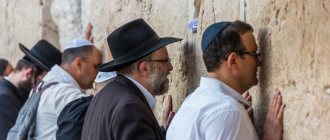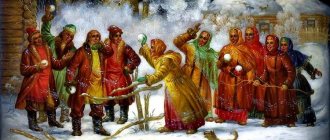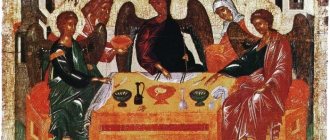Kazakhstan is a state with the longest land border in the world and Russia's closest eastern neighbor. On the territory of Kazakhstan there is the Arystan Baba mausoleum, a large Muslim shrine.
Since the 12th century, it was completely destroyed by earthquakes several times, while believers rebuilt it each time. The mausoleum was recognized as an object of cultural heritage back in Soviet times, and this fact is quite enough to correctly answer the question: what is the faith of the Kazakhs?
What is the faith and religion in Kazakhstan?
After reading the article, you will learn the entire religious spectrum of Kazakhstan in 15-19 minutes.
Thanks to the unique path of development and formation of the state, Kazakhstan today has a multinational population, which was formed through the resettlement of people from other regions. What is the faith and official religion of the Kazakhs in Kazakhstan today? Are there Orthodox churches in the country? Is shamanism widespread in the country? We invite you to find out the answers to these and other questions by plunging into the thousand-year history of the Kazakh people.
The content of the article:
- Religious affiliation of the population of Kazakhstan What is the main religion that predominates in Kazakhstan?
- Kazakhstan religion in percentage?
- Cultural history and origin of the Kazakh people Origin - history of the ethnogenesis of the Kazakh people
- Kara shanyrak is a special tradition
- What religion do Kazakhs profess in Kazakhstan?
- State religion of Kazakhstan
- Islam in Kazakhstan is the main religion Sunnis
- History of appearance
- Tengrism is the oldest religion among the Kazakhs
- Atheism
- The current state of religion in Kazakhstan
Culture
Culturally, Kazakhs became famous thanks to music. The melodies are performed by masters on the dombra, a miniature stringed instrument similar to a guitar. To the accompaniment of a musician, akyn singers perform folk songs. The Kazakhs, many centuries ago, developed a special form of competition - aitys. In it, everyone must demonstrate their musical talent. Even now, akyn is considered not just an occupation, but a real profession. The akyns did not sing according to the notes; they needed to compose rhymes almost on the go and manage to get on the beat. Thus, akyns' songs are based on improvisation, which makes the profession very difficult. Performing a song is not enough, because it must capture the mind and heart of the listener. Kazakh literature dates back many centuries, but its written form was formed no earlier than in the 19th century. During the Soviet period, oral literature dedicated to the revolution and its figures began to develop again. Soviet propaganda contributed to the popularization of Kazakh literature. In the middle of the last century, science fiction gained enormous popularity in Kazakhstan, and at the beginning of the 21st century, postmodernism was formed. Now the literature of Kazakhstan is increasingly gravitating towards the West. Kazakhstan is home to several world heritage sites listed as UNESCO sites.
Religious affiliation of the population of Kazakhstan
Kazakhstan today is a unitary republic with a presidential form of government. The constitution defines the republic as a secular state, but guarantees complete freedom of religion for the population.
Religion of Kazakhstan briefly:
According to statistical data, there are 46 faiths and dominations in Kazakhstan, representing the interests of a multi-ethnic people. Currently, there are about 4,200 religious communities and associations in the republic, and there are about 3,200 different houses of prayer, churches and mosques.
1.1. What is the main religion predominant in Kazakhstan?
During the 2009 population census, residents of Kazakhstan were asked about their attitude towards religion. The percentage of representatives of the prevailing religions turned out to be as follows: about 97% of respondents identified themselves as belonging to one faith or another, and 3% of respondents refused to answer or declared their atheism.
1.2. Kazakhstan religion in percentage:
- Muslims - 70.19%;
- Christians - 26.17%;
- Buddhists - 0.09%;
- Jews - 0.03%;
- other religions - 0.19%;
- atheists - 2.81%;
- did not give an answer - 0.51%.
Historically and culturally, society in the republic is oriented towards two traditional widespread religions - Sunni Islam and Orthodox Christianity. More than 11 million residents of Kazakhstan, including Kazakhs, Uzbeks, Kyrgyz and others, profess Sunni Islam, while Azerbaijanis adhere to the Shiite branch of Islam. The followers of Christianity in the republic are mainly Russians, Ukrainians, and Belarusians.
Housing
The traditional home of the Kazakhs is the yurt. Now this type of housing is not outdated; it is used by many farmers involved in livestock farming. The frame of the yurt consists of poles fastened crosswise, forming diamond-shaped holes. The shape of the dwelling is cylindrical with a cone-shaped roof, in the center of which there is a hole for the smoke to escape. For insulation, the yurt is covered with a thick layer of felt. In the center of the yurt there was a fireplace, near which firewood was stacked. The hearth served for heating and cooking. They ate food at small tables with low legs, sitting on carpets. The sleeping place was a collection of fur skins stacked on top of each other. Previously, only rich merchants could afford such luxury. Now many Kazakhs can stay comfortably in a yurt. The most honorable place is a small couch with high sides; a small foot table is placed next to it. Also, the head of the house can sit on a large chair, similar to a throne. Things are stored in chests; dishes should always be at hand. The entrance to the yurt is now closed by a door, which is protected by a canopy. The doors had not been used before. During ventilation, the canopy was raised, allowing air to naturally penetrate into the yurt. The space of the yurt is divided into male and female. Men usually position themselves closer to the front door. The symbol of wealth among the Kazakhs, as well as other nomadic peoples, is the mortar in which kumiss is beaten. Modern yurts are often used to attract tourists. Note that yurts can be used not only as individual hotels, but also as a place for funeral ceremonies. There are wedding yurts in which the bride and groom spend their first night after the wedding.
History of the Kazakh people
The history of the people of Kazakhstan goes back about 1000 years.
2.1 Cultural history and origin of the Kazakh people
In the formation of the Kazakh people, a key role was played, first of all, by the Aryans, who lived in ancient times in the territories from the Danube to Lake Baikal. Their mounds are found on the territory of modern Russia, Ukraine and throughout Kazakhstan.
2.1.1 Origin – history of the ethnogenesis of the Kazakh people
The first people inhabiting the territory of present-day Kazakhstan were nomadic cattle breeders of the Bronze Age. By the first century BC, a tribe of Huns settled in Central Asia and created the first nomadic empire in the region. These were typical Caucasians of the Andronovo type, fair-haired and green-eyed, who became the ancestors of the Sarmatians, Scythians, and Avars. After the Andronovo people, the Kazakhs retained many cultural customs - a nomadic lifestyle, writing, patterns on carpets, tamgas. In the second century BC, the Kangyu state was created, in which tribal unions played a key role.
This is interesting!
The term “Kazakh” itself comes from the Turkic word “Cossack”, which meant freedom-loving, free, wanderer.
2.1.2 Medieval history briefly
Turkic peoples came to dominate Central Asia during the Mongol invasion. This tribe, emerging from the Eurasian steppes, formed the largest state stretching from the Yellow to the Black Sea. Mongolian rulers, merchants, and warriors mixed with the local population, introducing Mongolian components into the gene pool of local peoples.
2.1.3 Kazakh Khanate
The origin of the Kazakh Khanate among the Kazakhs dates back to the mid-15th century, at which time the Golden Horde was almost defeated. Khan Kasym finally consolidated the tribes into the Kazakh nation, under him the number of people reached a million people. Around the same period, active Arab expansion of Central Asia began and, as a result, the spread of the Islamic religion. In favor of the teachings of the Prophet, the region also changed its cultural traditions - the Turkic writing is replaced by Arabic, the Arabic calendar is used, and the people celebrate Muslim holidays.
Until 1715, the Khanate grew and developed, until after the death of Khan Tauke it split into three territorial and economic associations, called zhuz. Soon after this division, a terrible danger loomed over the Kazakhs - the cruel and terrible Dzungar people from the Dzungar Khanate appeared.
REFERENCE!
They not only robbed the population, but also sought to completely exterminate it.
The only salvation for the Kazakhs was to find a powerful patron, which was Russia.
2.1.4 Kazakhs within the Russian Empire
In 1726, the Kazakhs sent representatives to Russia to ask for protection. And only in 1731, Empress Anna Ioannovna signed a charter on the annexation of the Junior Zhuz to Russia, which is considered the official entry of Kazakhstan into the Russian Empire.
For the Kazakh people, that time was an era of weak state power and protracted internal conflicts. At the end of the 18th century, fortresses began to be erected on the Russian-Kazakh border, which laid the foundation for the expansion of the Russian Empire deep into the Kazakh steppes. Over time, the khans decide to swear allegiance to Russia, thereby recognizing the undoubted power of the empire.
2.1.5 Kazakhs under the Soviet Union
In 1936, the Kazakh Autonomous Soviet Socialist Republic began to exist with its capital in Alma-Ata. Under Soviet rule, the Kazakh economy began to develop at an unprecedented pace. Industry was actively developing, virgin lands were being developed, and the Baikonur Cosmodrome was built. But there were also sad periods of forced collectivization, repression of the national intelligentsia, and mass famine that the people of Kazakhstan had to endure in the 20s and 30s of the 20th century. About 450 thousand Kazakhs take part in the Great Patriotic War, about half of them die on the battlefields.
2.1.6 Modern history of Kazakhstan
In December 1991, the full independence of the Republic of Kazakhstan was proclaimed. Today, the state of Kazakhstan ranks 9th in the world in terms of territory. The state borders on Russia, Uzbekistan, China, and Turkmenistan, so the government adheres to a balanced and consistent foreign policy. Now the country is home to more than 18 million people, and this figure is growing steadily.
2.2 Traditions and customs of Kazakhstan
Many features of the traditions and customs of the Kazakh people are related to family relationships and are based on respect for elders. The head of the family clan is considered the most respected person, and each family teaches the younger generation to know their clan to the seventh generation and beyond. Many customs are associated with hospitality (dastarkhan, sarkyt), as well as with important events in the life of the people - the birth of a child, a wedding, a funeral.
2.2.1 Kara shanyrak is a special tradition
This is interesting:
Kara shanyrak is an ancient Kazakh tradition when the youngest son in the family remains in the parental home to live with his parents until their death. This should happen regardless of his wishes.
2.2.2 National clothes
An important part of the national clothing of the Kazakhs is a robe made of suede or silk, cotton, wool, which is worn by both women and men. A popular headdress is the skullcap. Kazakh culture and traditions are replete with original elements: everything is richly decorated - from costumes and yurts to tools.
2.2.3 The main holiday is Nauryz
Nauryz is considered one of the main holidays in Kazakhstan; its celebration falls on the day of the spring equinox. On this day, people dress up, visit each other and treat themselves to the festive dish Nauryz-kozhe, which is traditionally prepared from seven ingredients - meat, fat, water, salt, flour, milk and cereals.
2.3 National composition of the state’s population - statistics
About 140 ethnic groups live in modern Kazakhstan, the indigenous of which, undoubtedly, are the Kazakh people. The Russian-speaking population represents approximately a third of the population and lives mainly in the northeast of the country. Large ethnic groups are statistically distributed in the republic (out of the total population) as follows:
- Kazakhs - 65%;
- Russians - 21.8%;
- Uzbeks - 3%;
- Ukrainians - 1.8%;
- Uighurs - 1.4%;
- Tatars - 1.2%;
- others (Moldavians, Chuvash, Bulgarians, Greeks, Mordovians and others) - 5.8%.
2.4 Beliefs of the Kazakhs - history of religion
2.4.1 What religion do Kazakhs profess in Kazakhstan?
The main religion of the Kazakhs is Islam, with the majority of people being Sunni followers. Orthodoxy is in second place in popularity, followed by atheism.
2.4.2 History of the penetration of Islam
The development of the Muslim religion began to occur at the end of the 6th century, thanks to Arab missionaries following the Silk Road. The dissemination of the teachings of the Prophet Muhammad in the territory of Central Asia took place through peaceful educational means, through the introduction of spiritual values into legislation.
2.4.3 When did the Kazakhs become Muslims?
At the end of the 10th century, Islam was officially established as the state religion. During the period of Soviet power, during the persecution of any religious activity, the popularity of Islam came to naught. For this reason, even today a minority of ethnic Kazakhs observe prayers and rituals.
2.5 The role of religion in the life of Kazakhs
In the life of modern Kazakhs, religion demonstrates its relevance even in modern realities, in the age of a market economy, computer technology and rational thinking. And even though only a minority of indigenous Kazakhs observe prayers and rituals today, it is considered important in the country to educate the younger generation to follow the Islamic faith.
The country's Islamic community includes more than two thousand religious associations. Since interfaith tolerance is strengthening in the country.
IMPORTANT!
Kazakhstan can be considered the only country in the world where there are no ethnic and religious differences, where people of different faiths live peacefully.
2.6 Famous representatives of the people
The leader of the Islamic community of the entire country, which includes more than two thousand religious associations, is the Grand Mufti, head of the Spiritual Administration of Muslims of Kazakhstan (SAMK) Yerzhan Mayamerov. The organization's activities are based on the Hanafi madhhab.
Abdulaziz Rasulov is an independent religious mentor, a phenomenal expert and reader of the Koran, and in the 80s of the 20th century he was a healer in Taldykorgan. Later he was officially approved as the imam of the city mosque.
Kazakhs under the Soviet Union
After the abdication of Emperor Nicholas II from the throne, political life revived on all the outskirts of the Russian Empire. The Second All-Kazakh Congress meets, where the creation of autonomy and a government that supports the Mensheviks is announced. In 1920, the autonomy was abolished by the Bolsheviks, who came to power, and its leaders were shot.
Soon after this, the Kyrgyz Autonomous Republic was formed with its capital in Orenburg. The Kazakh SSR began to exist only in 1936.
In the 20-30s, there was massive famine on the territory of modern Kazakhstan due to the policy of dispossession. About two million Kazakhs are dying, several hundred thousand people are fleeing to China. In 1937, repressions began that destroyed almost the entire intelligentsia.
Approximately 450,000 Kazakhs took part in the Great Patriotic War, about half of them remained on the battlefields.
Freedom of religion
Since the republic is now a secular system, the state and religion in Kazakhstan are separated from each other and there is no official national state religion.
Law on religion in Kazakhstan:
Every person has the right to profess those religious beliefs that he inherited from his ancestors or to which he feels gravitational.
3.1 State religion of Kazakhstan
The fundamental national religion here is Sunni Islam. The second most popular religion among the population is Orthodox Christianity. And although there is no formally official religion in the Republic of Kazakhstan, this issue is personal for each believer. The majority of citizens consider themselves believers, although they are not involved in the activities of religious organizations.
Main religions and religious denominations of Kazakhstan
How long is religion in Kazakhstan?
Nowadays, 17 faiths, which are part of the six major world religions, preach their teachings on the territory of Kazakhstan.
The world religions most widespread in Kazakhstan are Islam and Christianity. The next most widespread types of world religions are Judaism and Buddhism. There are also followers of Catholicism, Protestantism and groups of other faiths, such as the society of Buddhists, Baha'is, and Krishna Consciousness.
4.1 Islam in Kazakhstan is the main religion
The traditional religion on the territory of Kazakhstan is Sunni Islam of the Hanafi school, one of the four main legal schools of Muslims.
4.1.1 Sunnis
A split in the state led to the formation of Sunnism in the 7th century. This branch of Islam does not recognize any special spiritual power over other believers of any person. The rooting of religion began in the south of the country and by the end of the 9th century it spread widely throughout Central Asia on the coasts of the Syr Darya and Semirechye. Sunni Islam today includes four schools - madhhabs.
4.1.2 Features of Islam in Kazakhstan
Today, traditional Islam is spreading through regional branches of the Spiritual Administration of Muslims of Kazakhstan (SAMK). Modern adherence to the Muslim religion is characterized by tolerance, recognition of freedom of opinion, and tolerance of dissent. There is a lack of fanatical strictness in observing the ritual and legal norms of Sharia. Elements of Islam in the republic are more of a ritual or symbolic nature.
4.1.3 Muslim schools
From religious educational institutions in Kazakhstan the following were distributed:
- mekteb - primary schools;
- madrassas - higher schools.
Many Muslim schools operated at mosques; boys from the age of 4-5 attended them. We studied there from 3 to 12 years. The mektebs taught arithmetic, Arabic, calligraphy, and reading the Koran. To obtain a religious title it was necessary to study at a madrasah.
REFERENCE:
In 2001, the Nur-Mubarak University of Islamic Culture was opened in Almaty, which trains highly qualified imams, Islamic scholars and Arabic language teachers.
4.1.4 Public display of faith
Sometimes opportunities for worship are organized at the state level, such as religious literacy competitions. Every year hundreds of Kazakh Muslims perform the Hajj to Mecca. And although the majority of the population of Kazakhstan who professes Islam consider themselves believers, they do not regularly perform prayers and are not involved in the activities of religious communities.
4.1.5 Special clothing for women
In some Islamic countries, women are required to wear a hijab or burqa, which covers all parts of the body except the eyes. Although there is no direct indication of this, for example, of hiding hair, in the Koran.
The Supreme Mufti of Kazakhstan called for the issue of wearing religious clothing to be resolved locally, showing respect for the rules of the organization. For example, he advised parents to personally negotiate with a school or other educational institution.
4.1.6 Hanafi madhhab in Kazakhstan
The largest Hanafi school was founded by the outstanding Muslim theologian Abu Hanifa and proposed a theological methodology that became the basis of the school. The religious school of Abu Hanifa is considered the golden core of Kazakh Islam; its teachings are intertwined with the daily life of the Kazakhs, as they lie deeply in their national essence.
4.1.7 The emergence and spread of Islam on the territory of Kazakhstan
Islam began to appear on the territory of Kazakhstan during the time of the Arab expansion of Central Asia. Arab missionaries throughout the 7th and 8th centuries convinced the population to accept the teachings of the Prophet and set their own example of pious living.
4.2 Christianity in Kazakhstan
4.2.1 History
Historians associate the appearance of Christianity in Central Asia with the Sogdian tribes who moved along the Great Silk Road from Iran. During times of epidemics, they convinced the Turks to accept their faith and taught them to draw a cross on their foreheads as a symbol of religion.
4.2.2 Orthodoxy
Orthodox Christianity in Kazakhstan is widespread among the Slavic peoples - Russians, Belarusians, Ukrainians and others. Today Orthodoxy is a powerful religious movement in the country and is subordinate to the Moscow Patriarchate. There are 9 monasteries and 230 parishes on the territory of Kazakhstan.
4.2.3 Catholics in Kazakhstan
4.2.3.1 Emergence of Catholicism
Catholicism, as one of the branches of Christianity, entered the country during Soviet times through repressed people, among whom there were many Germans, Poles, Avars and others. These people, who had lost their home and civil rights, zealously practiced the religion of their ancestors and tried to preserve their national culture. The stronghold of the Catholic religion in Kazakhstan was the Poles who were forcibly resettled in the country in 1939 and the Germans who arrived there in 1941.
4.2.3.2 Catholic Church of Kazakhstan
Today, there are three dioceses of the Catholic Church in the country: in Astana, Almaty and Atyrau, as well as several Greek Catholic parishes.
4.2.4 Protestantism - history of the Protestant religion in Kazakhstan
This religion began to spread throughout the country through Lutheran soldiers and prisoners of war during the annexation of Kazakhstan to the Russian Empire. The following Protestant denominations are currently present in Kazakhstan:
- Lutheranism;
- baptism;
- Mennonite.
4.2.5 Buddhism
It is practiced mainly by Kalmyks and a small part of the Korean diaspora, approximately 15 thousand people. In Kazakhstan, Buddhism is represented rather poorly, but it has four official organizations: one line of Tibetan Buddhism, the rest represent Korean Song Buddhism.
REFERENCE!
It is worth noting that in Kazakhstan many representatives of the Korean community belong to various Catholic religious branches.
4.2.6 Judaism
In Kazakhstan, only the Orthodox branch of Judaism is represented, which became widespread with the decree of Nicholas I on military service for Jews. There are currently 5 operating synagogues in the country.
Appearance
Cloth
In winter, Kazakhs wore fur outfits using sable, marten, and raccoon skins. Sable and marten have always been considered the most expensive furs. Poor people could only use fur coats made from the skin of a domestic animal. These were not only sheep, but also camels. The main outerwear for men and women was the shapan - a wide robe, belted with a belt. There were quite a variety of types of hats:
- Felt cap.
- Boryk.
- Skullcap.
- Saukele.
The last version of the headdress is the most expensive. It was used only for a wedding or an important holiday. The Beldik belt was made of leather and velvet, decorated with silver, coins, and embroidery. Pendants were provided for belts used by warriors. Kazakh raincoats are called shekpen. They were made from undyed wool for everyday wear; ceremonial shekpen could be dyed purple or blue. The main footwear was shoes and boots, which were decorated with silver plaques. Men's boots were black, brown, gray. The woman was wearing red boots.
The Kazakhs did their best to create a culture that everyone could admire. Therefore, in recent years, tourism in their country has been developing at a very active pace. Political difficulties do not make them a less positive people, because they preserve the memory of their ancestors who survived a lot, managing to remain a united people.
Ancient religions of Kazakhstan
In ancient times, two main religions were widespread among the Kazakh people: Tengrism and shamanism.
5.1 Tengrism is the oldest religion among the Kazakhs
The main deity Tengri was associated with the sky; he was credited with controlling the forces of nature, people and spirits. According to this religion, the entire universe consisted of three parts. The world of heaven belonged to the deities, the middle world to people, and the underground world to dark forces. The cult of Tengri was perceived as accepting oneself as a part of nature, unity with it.
5.2 Shamanism
With the help of shamanic abilities, the ancient Kazakhs sought to prevent phenomena dangerous to society. Shamans were credited with the ability to prophesy, heal, contact otherworldly forces, and cause weather changes.
Reference:
With the spread of Islam, shamans began to be treated with caution, considering them associated with the devil. In general, representatives of Islam and shamanism exist peacefully.
Food
Kazakh cuisine should be divided into traditional and modern. It contains many traditions, which can be seen at the Toykazan festival. Cooking customs have evolved over centuries; there are many rituals associated with cooking. The basis of the Kazakh diet has always been meat dishes. It has many delicacies specific to Europeans. For example, kazy-karta, which is horse meat cut into slices. Kazakhs consume almost all food of animal origin: kidneys, heart, lungs, etc. Manti, which are prepared with the addition of meat and pumpkin, are very popular. They are steamed using a multi-layer wooden tray. Boiled sausage is also in demand. It is called kazy and is made from horse meat. Kazy sausage can have low, medium, or high fat content. The food of the nomads itself was always filling and fatty, since living conditions required them to eat heavily. There are also dishes that can really surprise you. Among them is a stuffed stomach, which is baked in ash. This dish is so specific that even settled Kazakhs rarely eat it. Among fish dishes, koktal is popular - this is fish that is smoked along with vegetables. A distinctive feature of the dish is the use of large individuals, weighing up to 5 kg. Poultry was excluded from food almost completely, since the nomads simply did not have it. There is also no pork, which is a prohibited product according to the instructions set out in the Koran. Kazakhs also have special drinks. To get a nutritious drink, they mix cow's milk with curdled milk, which is made from sheep's milk. The liquid is boiled, then butter is added. It turns out to be a very high-calorie drink. Bread is an important product in Kazakh cuisine. It is also made nutritious. For example, baursaks look like ordinary pieces of dough, but cook them in boiling oil and you get a hearty bread snack. Kazakhs bake flatbreads in the tandoor, and also make them in boiling oil (shelpek). You can prepare such bread dishes even on a camping trip, using a cauldron. Kazakhs perceive shelpek and baursaks as obligatory table decorations, but they can be more than enough. Bread is baked over coals, in a frying pan, and made into sweets. The most famous sweet is chak-chak, which can be eaten by anyone, even those on a diet. Shertpek is another matter - an extremely fatty sweet. It is honey mixed with horse fat obtained from making sausage. The diet of a modern Kazakh has become less caloric. People try to choose food that is consumed by Eastern peoples and Europeans. Many people are familiar with Russian, Belarusian and Ukrainian cuisines. Tatar and Korean dishes are often on the table; Kazakhs eat samsa, smoked meats, and various kinds of sweets familiar to every resident of a big city: ice cream, sweets, marmalade. Lagman and shish kebab remain unchanged dishes of the diet.
Other religions
6.1 Atheism
Today, about 5% of the population of Kazakhstan openly declares their atheism. Sometimes social conflicts occur on this basis, and there are also cases of discrimination against atheism in the media.
6.2 Sects and non-traditional religions
In modern Kazakhstan there are the following opposition communities that have broken away from the traditional religion:
- Wahhabism, Ismailis, Jadids - from Islam;
- Mormons, Jehovah's Witnesses, Molokans - from Christianity;
- Brahna Kumaris, Krishna Consciousness - from Buddhism.
6.3 Extremism
Manifestations of religious extremism in the country were associated with the activities of members of the radical organization Hizb-ut-Tahrir, whose activities have been banned since 2005. Kazakh extremists take their ideological origins from the Islamist movement “takfirism”.
Life
The life of Kazakhs living in Kazakhstan depends on the region. The peculiarities of the way of life have shaped the different views held by southerners and residents of northern regions. They resulted in a special kind of differences. For example, southerners can have three hundred guests come to their wedding celebration, while northerners prefer to invite only loved ones. In the north of Kazakhstan, winters are cold, so people are accustomed to temperatures of -20°C. And residents of the south can barely stand 10-degree frosts. Southerners are considered great adherents of old traditions, who strive to change their surnames so that they are more similar to Kazakh ones. Northerners remain closer to Russia, keeping surnames ending in “ev.” This is more likely due to a reluctance to get involved in bureaucratic delays - people in the north live more sedately, while in the south they are more fussy. Northern Kazakhs often communicate in Russian, while southern Kazakhs often use Uzbek. This is due to the influence of border states, which has been observed throughout the history of the Kazakhs. Finally, it is customary for southerners to pour very little tea, while northerners pour the drink to the very brim.
Religion in modern Kazakhstan today
7.1 Current state of religion in Kazakhstan
In 2011, Kazakhstan celebrated the twentieth anniversary of its independence. Over these years, there has been a real renaissance of religion in the culture of modern Kazakhstan, the number of religious associations has increased 6 times.
Today the country is flooded with various religious missions previously unknown to anyone. In the struggle for influence over believers, they often push aside the traditional religions of Kazakhstan, causing interfaith contradictions. However, now, as before, the dominant part of the country’s believing population are Muslims and Orthodox Christians.
7.2 Attitude to religion of parliamentary parties of Kazakhstan
There are three political parties in the country's parliament and they relate to religion in this way:
- the ruling Nur-Otan party does not mention any religion in its doctrine;
- the opposition Communist Party promotes the principles of atheism;
- The Ak Zhol democratic party supports traditional religions - Islam and Christianity.
Khazret Sultan Mosque in Astana (Nur-Sultan)
The Khazret Sultan Cathedral Mosque in Astana is the second largest mosque in Central Asia and is one of the unique cultural sites of the country. Its name means “Holy Sultan”; it was erected in honor of the Sufi sheikh Khoja Ahmed Yasawi, who is revered by the entire Muslim world. The architecture of the mosque amazes with its elegant oriental beauty and the unusual pattern of Kazakh ornaments.
Language
The Kazakh language was formed under the influence of the Turkic people and was influenced by other nationalities. Now there are several dialects:
- Northeastern.
- Southern.
- West.
Literary language is considered separately. The modern appearance of the language has undergone dramatic changes due to the formation of the so-called novodels. This is a group of words that appeared as a result of the influence of purism. Linguists note that many words look complicated, which is associated with the desire to increase the percentage of literary vocabulary in everyday spoken language (in particular, this is characteristic of purism). Kazakhs also note the ambiguity of the appearance of new models. It is difficult to say for sure whether they embellish the modern language or simply complicate it.









